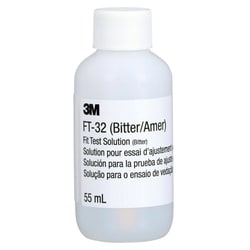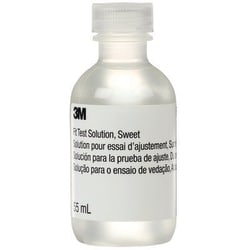Fit Testing Kits and Supplies
Respirator fit testing kits and supplies are designed to evaluate respirator fit, determine device suitability, and adhere to compliance requirements. Properly fitting respirators significantly reduce the risk of respiratory illness or injury due to exposure to hazardous airborne particles. There are two types of respirator fit testing: qualitative and quantitative.
Qualitative fit testing (QLFT) is a pass/fail test for a respirator utilizing a user’s sense of taste, smell, or reaction to an irritant. It does not measure the amount of leakage, but relies on personal detection. Examples of test agents include saccharin, isoamyl acetate (banana oil), Bitrex, and irritant smoke. A QLFT is required for negative-pressure, air-purifying respirators used in atmospheres where the hazard is at less than 10 times the permissible exposure limit (PEL). They are also required to test tight-fitting facepieces used with powered and atmosphere-supplying respirators.
Quantitative fit testing (QNFT) numerically evaluates respirator fit by measuring the leakage into the respirator. It compares the respirator leakage with ambient concentrations of the test agent. This test is used where higher respirator fit factors are essential for safety. A QNFT can be used to fit test any tight-fitting respirator. It involves using an instrument to measure leakage around the face seal and produces a numerical result called a 'fit factor.' A fit factor of at least 100 is required for half-mask respirators and a minimum fit factor of 500 for a full facepiece negative-pressure respirator.
Regulatory compliance details can be obtained at the individual product level.
Qualitative fit testing (QLFT) is a pass/fail test for a respirator utilizing a user’s sense of taste, smell, or reaction to an irritant. It does not measure the amount of leakage, but relies on personal detection. Examples of test agents include saccharin, isoamyl acetate (banana oil), Bitrex, and irritant smoke. A QLFT is required for negative-pressure, air-purifying respirators used in atmospheres where the hazard is at less than 10 times the permissible exposure limit (PEL). They are also required to test tight-fitting facepieces used with powered and atmosphere-supplying respirators.
Quantitative fit testing (QNFT) numerically evaluates respirator fit by measuring the leakage into the respirator. It compares the respirator leakage with ambient concentrations of the test agent. This test is used where higher respirator fit factors are essential for safety. A QNFT can be used to fit test any tight-fitting respirator. It involves using an instrument to measure leakage around the face seal and produces a numerical result called a 'fit factor.' A fit factor of at least 100 is required for half-mask respirators and a minimum fit factor of 500 for a full facepiece negative-pressure respirator.
Regulatory compliance details can be obtained at the individual product level.










